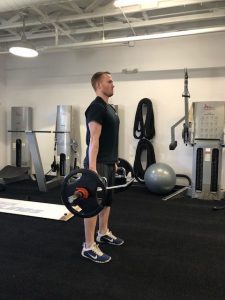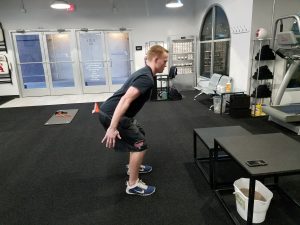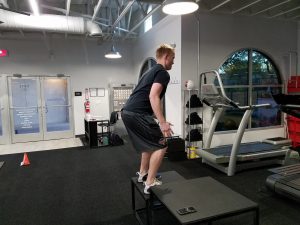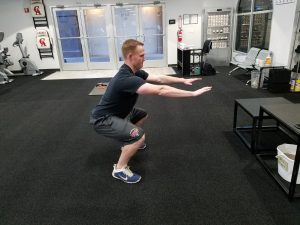Vertical French Contrast Protocol to Improve Explosive Work Capacity
By: Michael Zangl
The main goal of any training or general fitness program is to improve the capacity of force production over a greater distance in a shorter amount of time. In the athletic setting, the increased capacity to produce force over a greater distance and shorter time frame will be executed in some state of fatigue, and require an explosive effort regardless of the fatigued state. Over planned periods of time, implementing appropriate explosive movements, core exercises, and proper work: rest ratios will improve this ability in the traditional order of an exercise training program. A different way to improve force, velocity, and explosive capabilities under fatigue is the French Contrast Protocol.
The French Contrast Protocol is a specialized system of training for advanced athletes and trainees to improve force production, velocity, and explosive work in a fatigued state (Explosive Work Capacity). This specialized system of training will inhibit proprioception components inhibiting optimal power production (GTO), increase fiber recruitment, and increase calcium entry (a key component to optimal muscle contraction). The French Contrast Protocol involves four exercises in a quad set fashion to target all the components necessary to improve explosive work capacity.
The French Contrast Protocol is a combination of a traditional multi-joint strength exercise, complex training method, and contrast loading scheme. The complex training method requires the execution of a plyometric movement after the execution of a heavy multi-joint strength exercise. The plyometric movement will mimic the pattern performed during the heavy strength movement. Contrast loading requires execution of a drop in load for the same exercise after completing the heavy strength movement.
Here is the basic layout for the French Contrast Protocol:
Exercise #1: Heavy Multi-Joint Strength/Total Body Movement
Goal/Rationale: The first exercise is executed to enhance lower/upper body force production. Load of the exercise is important to elicit the appropriate adaptation necessary to utilize the second exercise. Many loading principles have been used to execute this movement (i.e. percentage based, repetition max based). Coaches will need to use loading consistent to the rest of their program structure.
Exercise #2: Plyometric Movement
Goal/Rationale: The second exercise is designed to take advantage of the potentiation created during the heavy strength/total body movement. After performing exercise #1, an increase in calcium entry occurs. The plyometric movement will utilize this entry in a fast and powerful manner, which will help elicit overall power output.
Exercise #3: Weighted/Loaded Plyometric Movement
Goal/Rationale: The weighted/loaded plyometric movement is the most important of the four exercises prescribed. This movement will target the ultimate goal of explosive work capacity. Performing a weight/loaded plyometric movement under fatigue is as close to sport-specific without performing the actual sport or being on the field/court during specific multi-directional speed sessions. Loading this exercise will be no more than half of the heavy strength/total body exercise performed, if same exercise is chosen (85% Strength = 40% Weighted Plyometric).
Exercise #4: Assisted/Plyometric Movement
Goal/Rationale: The final exercise is used to elicit a conditioning effect. Using assisted or unloaded exercises ensures the power output of the athlete doesn’t suffer based on the fatigue generated by the previous three exercises. Being able to maintain power output during fatigue states is crucial when it comes to winning/losing and defeating an opponent in a one-on-one situation.
Programming Considerations
The French Contrast Protocol should only be programmed for an experienced athlete or trainee. Due to the complex movements performed under fatigue, it must be implemented carefully. This protocol should be implemented during peaking phases of training closer to the main competition schedule. Incorporating this system too early in the training plan may create an unwanted adaptation during hypertrophy or general strength phases. 3 sets with 3-5 reps of each exercise is appropriate, and with only 5-10 sec of rest between exercises and 4-5 min of rest between sets. It will be the coach’s decision on what to do between sets (i.e. pre-hab work, torso training). Frequency will be limited to one day a week due to its tax on the body’s central nervous system.
Vertical French Contrast Protocol Example
There are many ways to design a French Contrast Protocol. The following will target vertical explosive work capacity. Vertical power performance is one of the best indicators of overall athletic performance. This vertical example will inch an athlete one step closer to improvement in this vital performance area.
Exercise #1: Trap-Bar Deadlift
Sets and Reps: 1 set x 3-5 repetitions
Rest Period: 5-10 sec before moving on to next exercise
Exercise #2: Box Jump
Sets and Reps: 1 set x 3-5 repetitions
Rest Period: 5-10 sec before moving on to next exercise
Exercise #3: MB Squat Jump
Sets and Reps: 1 set x 3-5 repetitions
Rest Period: 5-10 sec before moving on to next exercise
Exercise #4: Body Weight Speed Squat
Sets and Reps: 1 set x 3-5 repetition
Rest Period: Rest 4-5 min before repeating the quad set
Coach Zangl is a Lead Performance Movement Specialist at FMS Health and Safety, LLC in Irvine, California. Coach Zangl holds the following certifications: MA, CSCS, FMS, NSPA (CSAC, CWPC, CPDS, CSNC, MSPC). Coach Zangl was an assistant strength and conditioning coach at Sidelines or Headlines in North Scottsdale, Arizona, the head strength and conditioning coach at Bobby Crosby Baseball Academy working with baseball players and athletes of all ages, held a professional apprenticeship role at the University of Arizona, assisting in the overall development for the Wildcats Football, Baseball, M/W Tennis, Women’s Golf, Women’s Basketball and Track and Field teams. He also was an offensive line coach and strength and conditioning coordinator at Tesoro High School for 5 seasons and head football strength and conditioning coach at Athletes Choice in Rancho Santa Margarita.
Coach Zangl played football and baseball at Tesoro High School and went on to play football at Saddleback College. He was also a National Football Foundation and College Hall of Fame Scholar Athlete in 2010 and United States Marine Corp Male Distinguished Athlete Award Recipient. Coach Zangl graduated from Saddleback College as a scholar athlete with an Associate Degree in Liberal Studies, a Bachelor’s degree in Kinesiology with a focus in Sports Studies from California State University, Fullerton and a Master’s degree from Concordia University, Irvine in Coaching and Athletic Administration.
References
Chandler, J. T., & Brown, L. E. (2013). Conditioning for strength and human performance (2nd ed.). Philadelphia, PA: Lippincott Williams & Wilkins.
Chu, D. A. (1998). Jumping into plyometrics: 100 exercises for power and strength (2nd ed.). Champaign, IL: Human Kinetics.
Dietz, C., Peterson, B. (2012). Triphasic training: a systematic approach to elite speed and explosive strength performance.
Fleck, S. J., Kraemer, W. J. (2014). Designing resistance training programs (4th ed.). Champaign, IL: Human Kinetics.









0 Comments for “Vertical French Protocol”